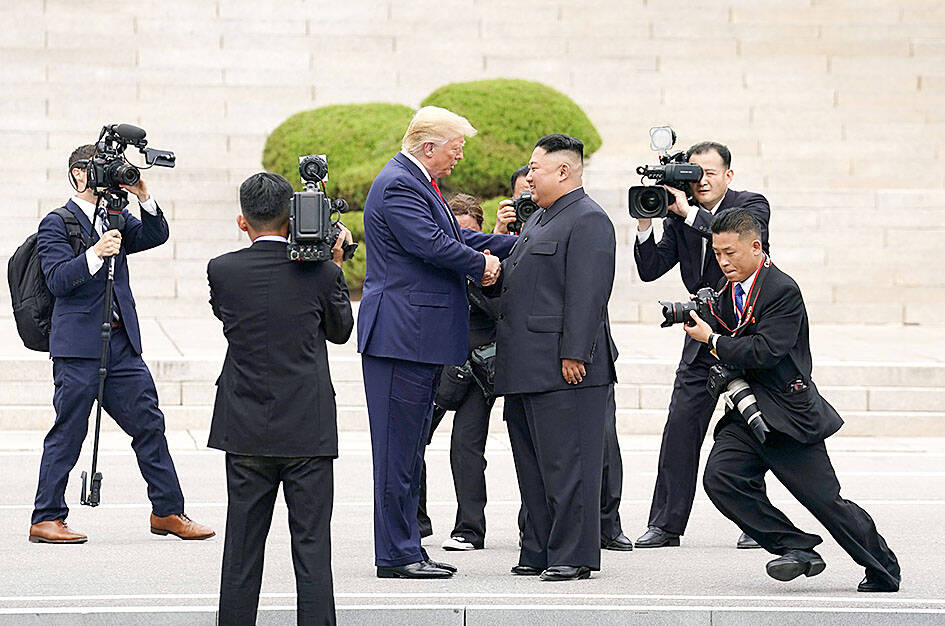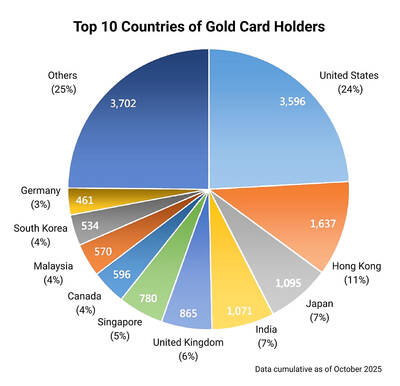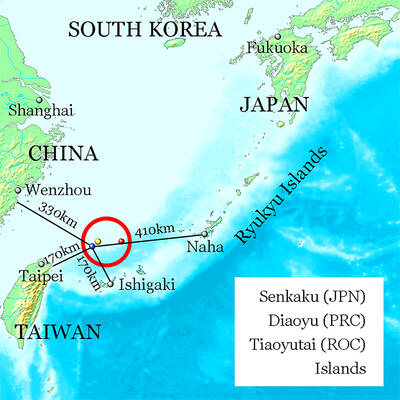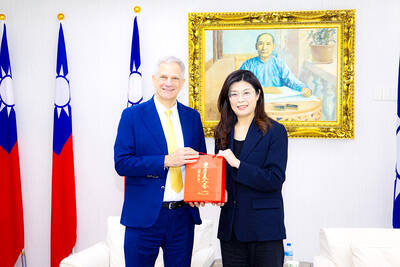Donald Trump’s unshakeable belief in his ability as a peacemaker has raised the prospect of another attempt to solve one of the world’s most implacable crises: North Korea’s continuing development of nuclear weapons.
During an occasionally fractious meeting with Lee Jae-myung in the White House on Monday, Trump did at least agree with South Korea’s liberal president on the need to engage with the North’s leader, Kim Jong-un.
“Someday I’ll see him. I look forward to seeing him. He was very good with me,” Trump told reporters, adding that he hoped talks could happen before the end of the year.

Photo: Reuters
If it happens, it would be the fourth time Trump has met the North Korean leader, with whom he has forged a close and potentially pivotal relationship. However, hopes for a breakthrough with a man Trump once derided as “little rocket man” appear to be as dim as ever.
In June 2018, the two held an unprecedented summit in Singapore, where they agreed to the “complete denuclearisation” of the Korean peninsula. Trump hailed the summit a success, but observers warned that, as one half of the peninsula in question, South Korea could have to end its dependence on US nuclear assets.
Trump was oblivious to more cautious voices, and arrangements were made for a second summit, in Hanoi in February 2019.
That was the moment Trump’s optimism crashed against the rocks of North Korean realpolitik and the realization that Kim was never going to abandon his nuclear deterrent and leave himself exposed to the fates that had befallen other US nemeses Colonel Muammar Gaddafi and Saddam Hussein.
The Hanoi summit was a study in the art of no deal, with both leaders departing early as North Korean and US statements blamed the other party for the failure to build on the consensus achieved in Singapore.
There was, though, one more opportunity for a meeting of minds, this time against a backdrop that has come to define the seven decades of tension since the 1950-53 war resulted in an uneasy truce and the formation of the world’s most heavily fortified border.
In June 2019, after making a quick exit from the G20 summit in Osaka, Japan, Trump stepped across the military demarcation line separating South and North Korea and patted Kim on the shoulder. Again, the optics were extraordinary, as Trump became the first sitting US president to stand on North Korean soil. Their meeting, though, produced little of substance.
And so the nuclear stalemate continues. The US and North Korea have not held high-level talks for almost six years, unable to agree among other things on how much sanctions relief Pyongyang should receive for moving to dismantle its nuclear program.
The long diplomatic pause has allowed North Korea to develop more sophisticated missiles and delivery systems — Lee said during his US visit that the regime now has the capacity to build 10 to 20 nuclear warheads a year, and needs only to perfect a re-entry vehicle to carry those warheads on ballistic missiles that can reach the US mainland.
It has also enabled Vladimir Putin — desperate to forge alliances while much of the world heaped condemnation on Russia’s invasion of Ukraine — to step into the void.
As Pyongyang and Moscow grow closer economically and militarily against the backdrop of the Ukraine war, the prospects for a successful US-North Korea summit appear dimmer than ever. And not even Lee’s suggested icebreaker — a round of golf on a North Korean course — is likely to change that.

Seven hundred job applications. One interview. Marco Mascaro arrived in Taiwan last year with a PhD in engineering physics and years of experience at a European research center. He thought his Gold Card would guarantee him a foothold in Taiwan’s job market. “It’s marketed as if Taiwan really needs you,” the 33-year-old Italian says. “The reality is that companies here don’t really need us.” The Employment Gold Card was designed to fix Taiwan’s labor shortage by offering foreign professionals a combined resident visa and open work permit valid for three years. But for many, like Mascaro, the welcome mat ends at the door. A

Last week gave us the droll little comedy of People’s Republic of China’s (PRC) consul general in Osaka posting a threat on X in response to Japanese Prime Minister Sanae Takaichi saying to the Diet that a Chinese attack on Taiwan may be an “existential threat” to Japan. That would allow Japanese Self Defence Forces to respond militarily. The PRC representative then said that if a “filthy neck sticks itself in uninvited, we will cut it off without a moment’s hesitation. Are you prepared for that?” This was widely, and probably deliberately, construed as a threat to behead Takaichi, though it

If China attacks, will Taiwanese be willing to fight? Analysts of certain types obsess over questions like this, especially military analysts and those with an ax to grind as to whether Taiwan is worth defending, or should be cut loose to appease Beijing. Fellow columnist Michael Turton in “Notes from Central Taiwan: Willing to fight for the homeland” (Nov. 6, page 12) provides a superb analysis of this topic, how it is used and manipulated to political ends and what the underlying data shows. The problem is that most analysis is centered around polling data, which as Turton observes, “many of these

Since Cheng Li-wun (鄭麗文) was elected Chinese Nationalist Party (KMT) chair on Oct. 18, she has become a polarizing figure. Her supporters see her as a firebrand critic of the ruling Democratic Progressive Party (DPP), while others, including some in her own party, have charged that she is Chinese President Xi Jinping’s (習近平) preferred candidate and that her election was possibly supported by the Chinese Communist Party’s (CPP) unit for political warfare and international influence, the “united front.” Indeed, Xi quickly congratulated Cheng upon her election. The 55-year-old former lawmaker and ex-talk show host, who was sworn in on Nov.